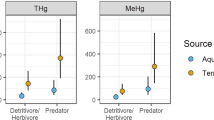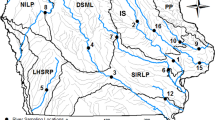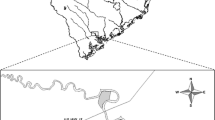Abstract
We compared contamination levels in fish from contaminated and uncontaminated floodplain swamps of the lower Mississippi River to assess differences in contamination risks between swamps, across different taxonomic and ecological groupings of fishes within and between swamps, and with seasonality in river stage. Fish tissue levels of inorganic contaminants were substantially lower than environmental levels in both swamps, suggesting either that fish were not uptaking these contaminants, or they were effectively eliminating the contaminants from their bodies. Tissue levels of organic contaminants were high relative to environmental levels, suggesting that these contaminants were bioaccumulating. Organic contaminants were significantly higher in fish from the contaminated swamp (Devil's Swamp) than in fish from a reference swamp up river (Tunica Swamp). Because the organic contaminants were largely confined to sediments, we expected bottom-oriented fishes to have higher concentrations than pelagic fishes. Assuming that uptake was primarily through the food chain, we expected top predators to exhibit higher concentrations than low-level consumers. We also expected year- round swamp residents to exhibit higher accumulations than more transitory users of backswamp habitat. However, organic contaminant levels did not differ in the directions expected for any of these groupings. We did observe differences in organic contaminant levels within and between swamps for different taxonomic groupings of fishes (species and genera). Some taxa occupying low to middle positions in the food web (e.g., gizzard shad, Lepomis spp.) exhibited higher concentrations than taxa near the top of the food web. Within Devil's Swamp, organic contaminant levels were significantly higher at low river stage, when fish were confined to the swamp, than at high river stage, when fish were free to move between the river and the swamp. We caught more species and more fish per unit effort in Devil's Swamp than in Tunica Swamp, contrary to expectations if contaminants in the former were negatively impacting population and community structure. Species richness differences between swamps were a consequence of catch differences, with higher catch corresponding to inclusion of more rare species. The lower catch in Tunica Swamp may have resulted from physical modifications of its waterways to support agriculture and hunting. The results of this study underscore the importance in factoring information on the taxonomy and ecology of organisms, and seasonal changes in environmental conditions, into assessments of contamination risks.
Similar content being viewed by others
References
ATSDR (1994) Toxicological profile for hexachlorobutadiene. Agency for Toxic Substances and Disease Registry, Document No. TP93/08. Atlanta, Ga.
Baker, J.A., Kilgore, K.J. and Kasul, R.L. (1991) Aquatic habitats and fish communities in the Lower Mississippi River. Rev. Aquatic Science 3(4), 313-56.
Carlander, K.D. (1969) Handbook of freshwater fishery biology, Volume one. Ames: Iowa State Univ. Press.
Carlander, K.D. (1977) Handbook of freshwater fishery biology, Volume two. Ames: Iowa State Univ. Press.
Conner, J.V. and Bryan, C.F. (1974) Review and discussion of biological investigations in the Lower Mississippi River and Atchafalaya River. Proc. 28th Ann. Conf. Southeast. Assoc. Game and Fish. Comm. 28, 429-39.
EPA (1992) National study of chemical residues in fish, Volume I. EPA 823-R-92-008a, U.S. Environmental Protection Agency.
Guillory, V.A. (1979). Utilization of an inundated floodplain by Mississippi River fishes. Fla. Sci. 42, 222-8.
Henrich, M.D., Hindrichs, A.E. and Fleming, M.N. (1995) Mississippi River Toxics Inventory Project: Fish and Shellfish Sampling Plan. Louisiana Department of Environmental Quality, Water Quality Management Division.
Kolok, A.S., Groetsch, K.J. and Oris, J.T. (1996) The role of water ventilation and sediment ingestion on the uptake of hexachlorobenzene by gizzard shad (Dorosoma cepedianum). Environmental Toxicology and Chemistry. 15(10), 1760-2.
Lambou, V.W. (1959) Fish populations of backwater lakes in Louisiana. Trans. Am. Fish. Soc. 88(1), 7-15.
Ludwig, J.A. and Reynolds, J.F. (1988) Statistical ecology. New York: Wiley Interscience.
PRC (1987) Expanded site inspection for Devil's Swamp Lake (LAD985202464) East Baton Rouge Parish Louisiana. Unpublished report to the U.S. Environmental Protection Agency on contract no. 68-W9-0006, PRC, Environmental Management, Inc.
PRC (1993) Expanded site inspection for Devil's Swamp (LAD981155872) East Baton Rouge Parish Louisiana. Unpublished report to the U.S. Environmental Protection Agency on contract no. 68-W9-0006, PRC, Environmental Management, Inc.
Author information
Authors and Affiliations
Rights and permissions
About this article
Cite this article
Bart, H.L., Martinat, P.J., Abdelghani, A. et al. Influence of Taxonomy, Ecology, and Seasonality in River Stage on Fish Contamination Risks in Floodplain Swamps of the Lower Mississippi River. Ecotoxicology 7, 325–334 (1998). https://doi.org/10.1023/A:1008811713427
Issue Date:
DOI: https://doi.org/10.1023/A:1008811713427




